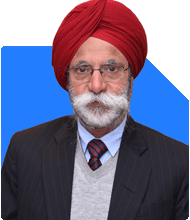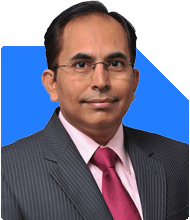Ramalingam Kalirajan |10902 Answers |Ask -Follow
Mutual Funds, Financial Planning Expert - Answered on Dec 09, 2024
He has an MBA in finance from the University of Madras and is a certified financial planner.
He is the director and chief financial planner at Holistic Investment, a Chennai-based firm that offers financial planning and wealth management advice.... more

Hello Hemant, i need your help in solving a crisis, it is not unmanageable but, with your help i can improve. so here are the details. Income 1,40,000 PM Loans running (20 Lakhs) 38,000 PM (Personal Loan taken for 8 years 4th year running) Car loan (10 Lakhs) 17,500 PM (For 7 years 4th year running) Investments 3,000 SIP (Current value is 1,07,000) Invested in stocks 7,50,000 (Current value 8,15,000) PPf 2,50,000 (2,000 PM) Investment in gold 1000 PM since 1 year (Invested 15,000 current value 18,000) I want to reach a target of 3 crores, iam currently aged 45, iam in govt service so still have 9 yrs of service left with the same income or u can say an increment of 10% PA. rrequest help and advice
However, your loan EMIs of Rs 55,500 per month take a significant portion of your income. This affects your savings and investment potential.
Your target of Rs 3 crores in 9 years is ambitious but achievable with strategic planning.
Analysis of Current Investments
SIPs (Rs 3,000 per month):
Your SIP contributions are small compared to your income.
A higher allocation is needed to build a significant corpus.
Stocks (Rs 7.5 lakh invested, Rs 8.15 lakh current value):
Direct equity investment has shown moderate returns.
Stocks can be volatile, requiring proper diversification.
PPF (Rs 2.5 lakh, Rs 2,000 per month):
PPF provides secure, tax-free returns but has limited growth potential.
The 15-year lock-in also affects liquidity.
Gold (Rs 15,000 invested, Rs 18,000 current value):
Gold is a hedge against inflation but is not suitable for high growth.
Monthly investments in gold are not significant for your target.
Evaluating Loans and Debt
Personal Loan (Rs 20 lakh, Rs 38,000 EMI):
Personal loans carry higher interest rates.
You have 4 more years left to repay this loan.
Car Loan (Rs 10 lakh, Rs 17,500 EMI):
Car loans are a depreciating asset liability.
The 3 years remaining on the loan strain your cash flow.
Steps to Improve Cash Flow
Accelerate Loan Repayments:
Prioritise clearing the personal loan first.
Use any bonuses or surplus income to reduce loan tenure.
After the personal loan, focus on prepaying the car loan.
Limit New Borrowings:
Avoid taking additional loans until existing debts are cleared.
Maintain a clear focus on financial discipline.
Strategy for Rs 3 Crore Goal
Increase SIP Contributions:
Raise your monthly SIP to Rs 15,000 initially.
Gradually increase SIPs by 10-15% annually as your income grows.
Invest in actively managed funds for higher returns.
Rebalance Stock Portfolio:
Diversify into equity mutual funds to reduce direct equity risks.
Focus on funds managed by experienced professionals.
Enhance PPF Contribution:
Maximise PPF contributions to Rs 1.5 lakh annually for tax benefits.
Treat it as part of your debt allocation.
Limit Gold Investments:
Stop monthly investments in gold.
Reallocate this amount to equity or hybrid funds.
Build an Emergency Fund:
Maintain 6 months’ expenses in a liquid fund or savings account.
This ensures liquidity during unexpected situations.
Tax Implications
For equity mutual funds, LTCG above Rs 1.25 lakh is taxed at 12.5%.
STCG is taxed at 20%.
Plan redemptions carefully to minimise tax liabilities.
Monitoring and Review
Track Progress Regularly:
Review your investments every 6 months.
Adjust allocations based on performance and goals.
Seek Professional Advice:
Consult a Certified Financial Planner to create a tailored plan.
Avoid emotional decision-making in investments.
Final Insights
Your financial discipline and stable income provide a strong foundation. Clearing debts and reallocating investments can help you achieve your Rs 3 crore target. Stay focused and consistent in your approach.
Best Regards,
K. Ramalingam, MBA, CFP,
Chief Financial Planner,
www.holisticinvestment.in
https://www.youtube.com/@HolisticInvestment
You may like to see similar questions and answers below
Ramalingam Kalirajan |10902 Answers |Ask -Follow
Mutual Funds, Financial Planning Expert - Answered on Jul 16, 2024
Ramalingam Kalirajan |10902 Answers |Ask -Follow
Mutual Funds, Financial Planning Expert - Answered on May 21, 2025
Ramalingam Kalirajan |10902 Answers |Ask -Follow
Mutual Funds, Financial Planning Expert - Answered on Jun 02, 2025
Ramalingam Kalirajan |10902 Answers |Ask -Follow
Mutual Funds, Financial Planning Expert - Answered on Jul 13, 2025
Anu Krishna |1749 Answers |Ask -Follow
Relationships Expert, Mind Coach - Answered on Dec 17, 2025
Anu Krishna |1749 Answers |Ask -Follow
Relationships Expert, Mind Coach - Answered on Dec 17, 2025
Radheshyam Zanwar |6748 Answers |Ask -Follow
MHT-CET, IIT-JEE, NEET-UG Expert - Answered on Dec 17, 2025
Anu Krishna |1749 Answers |Ask -Follow
Relationships Expert, Mind Coach - Answered on Dec 17, 2025
Dr Shakeeb Ahmed Khan |184 Answers |Ask -Follow
Physiotherapist - Answered on Dec 17, 2025
T S Khurana |538 Answers |Ask -Follow
Tax Expert - Answered on Dec 17, 2025
T S Khurana |538 Answers |Ask -Follow
Tax Expert - Answered on Dec 17, 2025
Janak Patel |72 Answers |Ask -Follow
MF, PF Expert - Answered on Dec 17, 2025
Ramalingam Kalirajan |10902 Answers |Ask -Follow
Mutual Funds, Financial Planning Expert - Answered on Dec 17, 2025
Samraat Jadhav |2511 Answers |Ask -Follow
Stock Market Expert - Answered on Dec 17, 2025

























